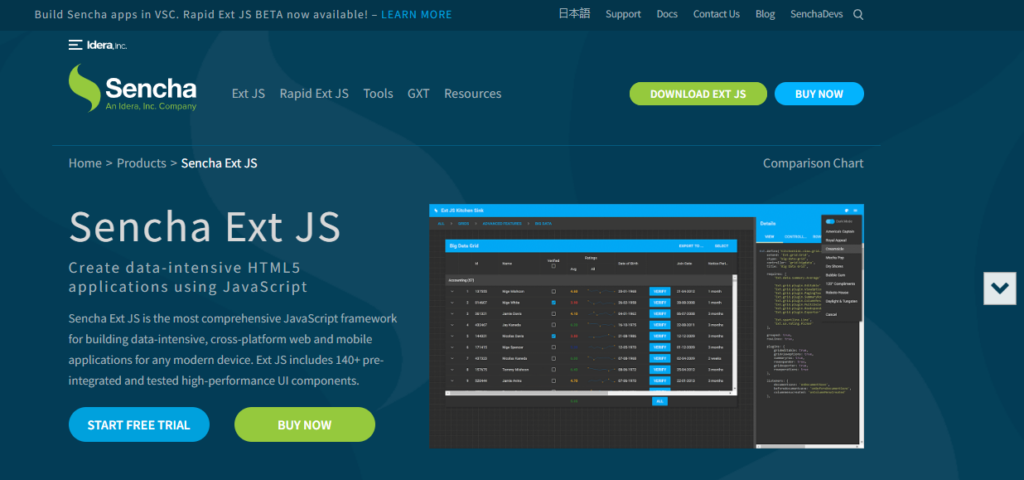Welcome to our guide on optimizing your website’s front-end performance in 2024. We’ll walk you through why it’s crucial, what key metrics and tools to focus on, and practical steps you can take to make your website faster and more user-friendly. You must know that a slow-loading website always results in frustration, right? In 2024, people expect websites to be lightning-fast. Slow sites irritate users and hurt your site’s visibility on search engines. But you can avoid it using the right front-end framework, like the Ext JS front-end framework.
We’ll explain how the choice of tools and technologies can affect your website’s speed and performance. It is also affected by the choice of a front-end framework. Moreover, we will give our users simple tips for making our website faster. Moreover, you will also learn about Progressive Web Apps (PWAs) and why they’re valuable. With more people using phones, we’ll discuss why optimizing for mobile devices is crucial.
Lastly, we’ll give you a sneak peek into what’s coming next in web development. By the end, you’ll have a clear understanding of how to make your website faster, more user-friendly, and ready for the future of the web in 2024.

Why is optimizing frontend important?
Frontend optimization is about making websites and apps work faster and better. It’s like making sure a car runs smoothly. When we talk about “frontend performance,” we mean how quickly and smoothly the parts of a website you see and interact with load and work.
Why is this important? Well, think about it when you visit a website. If it takes forever to load, you might get frustrated and leave. That’s called a “bounce.” Fast websites make people happy and stay longer, which is good for businesses.
If a website’s front end isn’t optimized, it can lead to problems like people leaving quickly or not buying things. Slow and glitchy websites make people give up. So, when we make the front end work well, we make users happy, and businesses do better.

What are the frontend performance metrics and tools?
Frontend performance metrics and tools are like gauges that help us see how fast and smooth a website or web app works. Think of them as indicators that show us if a webpage is quick to appear on your screen and easy to use. Here are five important ones:
1. Page Load Time
This is how long it takes for a webpage to show up completely. Faster load times keep people interested in the site.
2. First Contentful Paint (FCP)
FCP is like the moment you see the first image or text when you open a webpage. It tells you that the page is coming.
3. Largest Contentful Paint (LCP)
LCP measures how fast the biggest thing on the page, like a big picture or video, shows up. This matters because it makes the page look good.
4. Cumulative Layout Shift (CLS)
CLS checks if things on the webpage suddenly jump around when it loads. You don’t want this because it’s annoying.
5. Time to Interactive (TTI)
TTI is when the webpage is ready for you to click buttons and do things. Faster TTI means you can use the site sooner.

Does the choice of front end framework affect the front end performance?
The choice of a front-end framework plays a critical role in determining front-end performance. Different frameworks, such as React, Angular, Vue.js, or Sencha Ext JS, offer varying levels of optimization and efficiency.
Bundle size, rendering speed, and data handling capabilities impact overall performance. Sencha Ext JS is one of the most popular frontend frameworks for the web development process. Utilizing efficient cross-platform development frameworks like Sencha Ext JS accelerates application development, saving time and resources.
Consequently, enterprises are increasingly adopting the trusted Sencha Ext JS framework for constructing high-performing cross-platform applications.

How to optimize front-end speed?
Here are some steps that developers should take to optimize front-end speed.
1. Browser caching
Think of it like saving a copy of a webpage on your computer. When you visit the same page again, it loads faster because some parts are already stored on your device.
2. Content delivery networks (CDNs)
These are like special delivery networks for website stuff. They keep copies of your website in many places, so when someone visits your site, they get it from the nearest place, making it faster.
3. Lazy loading of images and assets
This means only loading pictures and extra things on a webpage when you scroll down to see them rather than loading everything at once, which can be slow.
4. Reducing server response times
Imagine a waiter at a restaurant. You get frustrated if they take a long time to bring your food. It’s the same with websites – making the server (the computer serving the website) respond quickly is important for speed. This is done by improving the website’s coding and how it talks to the server.
Unlock the Future of Web Development with Sencha – Get Started Now!

How to enhance user experience at the front end?
Improving the user experience on a website’s front end can be made simpler by following these steps:
Reducing render-blocking resources
Avoid using too many complex elements like JavaScript and fancy design styles that can make the page load slowly.
Optimizing critical rendering path
Focus on making sure the most important parts of the page appear fast so users don’t have to wait too long.
Implementing responsive design for mobile performance
Design the website to look good and work smoothly on small screens like smartphones.
Handling third-party scripts and integrations
Be selective about using outside features and tools on your site, as they can slow it down. If you do use them, make sure they don’t cause delays.

What Is the connection between web accessibility and front-end performance?
Accessibility and performance are crucial aspects of web design, and they are closely linked. Accessibility means making websites usable for people with disabilities so everyone can use them. Performance is about making websites fast and work smoothly.
To make websites accessible and fast, developers should follow some good practices. They should write code and use images to make websites load quickly. This helps all users, including those with disabilities who might use special tools to browse the web.
Also, making websites accessible often means organizing the code better, which can improve performance. By caring about accessibility and performance, we create websites that work well for everyone, making the web a better place for all users.

What are the benefits of progressive web apps (PWAs)?
Progressive Web Apps (PWAs) are a modern way to build websites with great benefits.
First, they load fast, even if your internet is slow. This means you don’t have to wait long to see the content.
PWAs also work offline because they store some information on your device, so you can still use them without an internet connection. This is handy in a place with bad or no internet.
Plus, PWAs can act like regular apps on your phone. They send you updates and notifications, just like your favorite apps.
And you don’t have to go to an app store to download them; you can use them directly from a web link. PWAs make websites more user-friendly and engaging.

What is the importance of mobile optimization in 2024?
Mobile optimization is super important in 2024 because most people use their smartphones to surf the internet. People might leave if your website isn’t good on mobile because it’s too slow or ineffective. This can also make your site show up lower on Google.
To make things better, there are some tricks like AMP (Accelerated Mobile Pages). Special web pages load fast on mobile phones, so people don’t have to wait.
Another cool thing is lazy loading. It’s when images and stuff on your site only load when you scroll down. This makes your site load quicker and saves people’s data.
In 2024, making your site work well on mobiles is a big deal for happy users and better results.

What are the upcoming trends and technologies that will impact front-end performance?
Future-proofing front-end performance is crucial as the web keeps changing. Imagine it like preparing for new technology and trends that can affect how fast websites and apps work. For example, with faster 5G internet, we must ensure websites load quickly and efficiently.
Also, things like Progressive Web Apps (PWAs) and serverless tech are becoming important. This means we need to learn and adapt to these new website-building methods.
To stay on top, developers should keep learning and open to new tools and ideas. Frontend frameworks like Sencha Ext JS, React, or Vue can help make websites better. Being adaptable and learning new stuff is the key to making sure your websites run well in the future.

Conclusion
In the ever-evolving digital landscape of 2024, optimizing front-end performance is a critical goal for web developers. Key takeaways include smart loading, code organization, and file compression to ensure swift website accessibility. Content Delivery Networks (CDNs) and Progressive Web Apps (PWAs) are valuable allies for enhancing user experiences.
Remember that monitoring using metrics like LCP and CLS is a continuous process. User-centric design and regular testing, alongside staying up-to-date with industry trends, are paramount. The journey of front-end performance optimization never truly ends; it’s a perpetual commitment to delivering seamless, fast, and user-friendly websites in the digital age.
FAQs
What are the main types of front-end frameworks?
The main types of front-end frameworks are JavaScript, CSS, and HTML frameworks, with popular examples like Ext JS, React, Angular, and Vue.
What is a front-end framework, and why is it important in web development?
A front-end framework is a pre-built set of tools and templates for web development, making it faster and more efficient.
Are front-end frameworks suitable for all types of web projects?
Front-end frameworks are versatile but unsuitable for all web projects; choose based on project complexity and requirements.
What is the most commonly used front-end framework?
Ext JS is one of the most commonly used front-end frameworks in 2024.











Leave a Reply